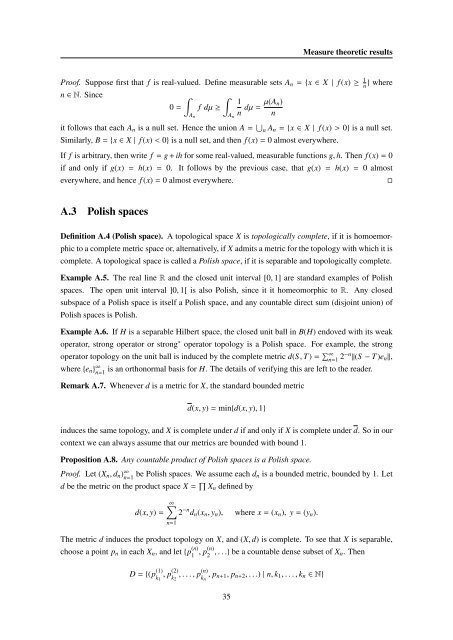Disintegration theory for von Neumann algebras
Disintegration theory for von Neumann algebras
Disintegration theory for von Neumann algebras
Create successful ePaper yourself
Turn your PDF publications into a flip-book with our unique Google optimized e-Paper software.
Measure theoretic results<br />
Proof. Suppose first that f is real-valued. Define measurable sets A n = {x ∈ X | f (x) ≥ 1 n } where<br />
n ∈ N. Since<br />
∫ ∫<br />
1<br />
0 = f dµ ≥<br />
A n A n<br />
n dµ = µ(A n)<br />
n<br />
it follows that each A n is a null set. Hence the union A = ⋃ n A n = {x ∈ X | f (x) > 0} is a null set.<br />
Similarly, B = {x ∈ X | f (x) < 0} is a null set, and then f (x) = 0 almost everywhere.<br />
If f is arbitrary, then write f = g + ih <strong>for</strong> some real-valued, measurable functions g, h. Then f (x) = 0<br />
if and only if g(x) = h(x) = 0. It follows by the previous case, that g(x) = h(x) = 0 almost<br />
everywhere, and hence f (x) = 0 almost everywhere.<br />
□<br />
A.3 Polish spaces<br />
Definition A.4 (Polish space). A topological space X is topologically complete, if it is homoemorphic<br />
to a complete metric space or, alternatively, if X admits a metric <strong>for</strong> the topology with which it is<br />
complete. A topological space is called a Polish space, if it is separable and topologically complete.<br />
Example A.5. The real line R and the closed unit interval [0, 1] are standard examples of Polish<br />
spaces. The open unit interval ]0, 1[ is also Polish, since it it homeomorphic to R. Any closed<br />
subspace of a Polish space is itself a Polish space, and any countable direct sum (disjoint union) of<br />
Polish spaces is Polish.<br />
Example A.6. If H is a separable Hilbert space, the closed unit ball in B(H) endoved with its weak<br />
operator, strong operator or strong ∗ operator topology is a Polish space. For example, the strong<br />
operator topology on the unit ball is induced by the complete metric d(S, T) = ∑ ∞<br />
n=1<br />
2 −n ||(S − T)e n ||,<br />
where {e n } ∞ n=1<br />
is an orthonormal basis <strong>for</strong> H. The details of verifying this are left to the reader.<br />
Remark A.7. Whenever d is a metric <strong>for</strong> X, the standard bounded metric<br />
d(x, y) = min{d(x, y), 1}<br />
induces the same topology, and X is complete under d if and only if X is complete under d. So in our<br />
context we can always assume that our metrics are bounded with bound 1.<br />
Proposition A.8. Any countable product of Polish spaces is a Polish space.<br />
Proof. Let (X n , d n ) ∞ n=1 be Polish spaces. We assume each d n is a bounded metric, bounded by 1. Let<br />
d be the metric on the product space X = ∏ X n defined by<br />
d(x, y) =<br />
∞∑<br />
2 −n d n (x n , y n ), where x = (x n ), y = (y n ).<br />
n=1<br />
The metric d induces the product topology on X, and (X, d) is complete. To see that X is separable,<br />
choose a point p n in each X n , and let {p (n)<br />
1 , p(n) 2 , . . .} be a countable dense subset of X n. Then<br />
D = {(p (1)<br />
k 1<br />
, p (2)<br />
k 2<br />
, . . . , p (n)<br />
k n<br />
, p n+1 , p n+2 , . . .) | n, k 1 , . . . , k n ∈ N}<br />
35

















